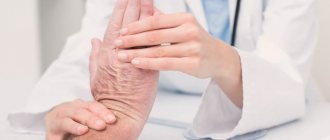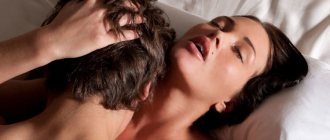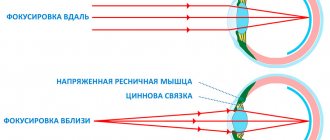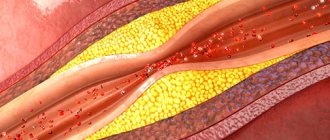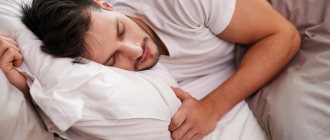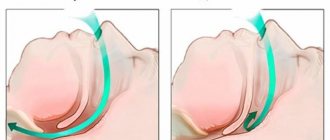In this article we will learn what Nocturnal Epilepsy or Sleep Epilepsy is, we will find out what seizures can occur during sleep, what are the differences between epilepsy in sleep and sleep disorders. Epileptic seizures in relation to the time of day can be: only nocturnal attacks, mainly nocturnal, attacks at any time of the day, only daytime. The characteristic time of epilepsy attacks during sleep is when falling asleep or waking up, especially with early forced awakening or sleep deprivation (sleep deprivation).
It is known that a third of all patients with epilepsy (according to various sources, 10-45%) have only epileptic seizures at night or occur mainly during sleep, that is, about 30% have epilepsy during sleep.
Patients have dubbed this sleep-related epilepsy nocturnal epilepsy. Although such a term has not been officially introduced in epileptology.
There are a number of terms related to sleep-related events:
- epileptic seizures associated with sleep;
- nocturnal attacks;
- nocturnal paroxysms;
- attacks when falling asleep (on awakening, against the background of sleep deprivation);
- paroxysms during sleep of non-epileptic origin;
- parasomnias (somnambulism = sleepwalking, somnylakia = sleepwalking);
- insomnia;
- sleep disorders;
- hyperkinesis;
- benign myoclonus when falling asleep and other options.
So many terms related to nocturnal attacks indicate the variability of manifestations during sleep, the high frequency of paroxysms, and the complexity of diagnosis. Combinations of several of these and other disorders are possible with and without epilepsy.
Nocturnal epilepsy causes
The likelihood of epilepsy attacks occurring during sleep is determined by sleep physiology. Let's find out what happens in the cerebral cortex during epilepsy during sleep.
During sleep, the excitability of nerve cells changes, their work becomes asynchronous.
Sleep may be disturbed with epilepsy, more often with focal forms.
During epileptic seizures, the EEG shows an increase or increase in the epiactivity index during the slow-wave sleep phase. During the rapid eye movement sleep phase, there is a violation of the synchronicity of bioelectrical activity. Due to the asynchrony of discharges during the rapid eye movement sleep phase, the spread of discharges to other parts of the brain is suppressed.
When sleep phases are disturbed, with a shortening of the rapid eye movement sleep phase, excitability is noted, and on the EEG there is an increase in the spread of discharges, which is sometimes called a decrease in the threshold of convulsive readiness.
Sleep deprivation causes increased sleepiness, which promotes falling asleep during EEG recording. When recording an electroencephalogram during sleep, pathological activity is more likely to be detected.
In addition to sleep deprivation, epiactivity can be provoked by forced awakening, rich food, and certain medications (mild sedatives).
Generalized epilepsy and sleep
Seizures during sleep are characteristic of idiopathic generalized epilepsy. This connection is explained by damage to thalamocortical structures.
In idiopathic generalized epilepsy, sleep deprivation stimulates epiactivity and increases the likelihood of an epileptic seizure.
Attacks more often occur when falling asleep or waking up, especially with early forced awakening.
Thus, in the first 15 minutes - 1 hour after getting up, patients with juvenile myoclonic epilepsy experience epileptic seizures: myoclonus (usually in the form of twitching in the hands) or, especially with ineffective therapy, generalized tonic-clonic seizures.
In epileptic encephalopathies with electrical status of slow-wave sleep (ESES), even from the name it is clear that the manifestations of the disease are associated with sleep. A feature of these forms of epilepsy is the presence of continued epileptiform activity with a high epiactivity index (more than 80%) during the slow-wave sleep phase. And during the rapid eye movement sleep phase, the epiactivity index decreases.
Nocturnal seizures in epileptic encephalopathies with electrical status of slow-wave sleep can be in the form of: focal motor seizures during sleep, generalized tonic-clonic seizures. Daytime attacks, both focal and generalized, are also possible.
Symptomatic secondary generalized epilepsy is less dependent on sleep-wake cycles. With this form of epilepsy, epileptiform activity and seizures can occur at any time of the day with equal probability.
• Macronutrient deficiency
The most common cause of painful cramps in the calf muscle is a lack of elements such as magnesium, calcium or potassium. This is due to the fact that these elements are involved in conducting nerve impulses to the muscle and ensuring its contraction. If, in addition, there is a deficiency of vitamins in the body, such as D and B, then the risk of seizures increases. A deficiency of these mineral salts occurs when they are insufficiently supplied from food, poorly absorbed, or increased excretion from the body. Dehydration, taking medications that interfere with the absorption of these minerals, severe stress, pregnancy, excessive sweating, etc. may be to blame.
Nocturnal epilepsy symptoms
With autosomal dominant nocturnal frontal lobe epilepsy, the following nocturnal attacks are observed:
- attacks upon sudden awakening at night, can be short, sometimes missed by patients, can be accompanied by screaming, affect (fear);
- hypermotor attacks (high-amplitude, fanciful movements), tonic (stretching, arching), clonic (sharp contractions of the muscles of the limbs, torso), consisting of cyclic movements (boxing, pedaling) or pushing;
- nocturnal attacks similar to sleepwalking, accompanied by fear (for example, jumping out of bed, running, looking around, screaming, speaking articulate phrases);
- There may be various combinations of these attacks during sleep.
Features of symptoms of autosomal dominant nocturnal frontal lobe epilepsy:
- family history of epilepsy is burdened (relatives have cases of epilepsy or parasomnias);
- onset of epilepsy at puberty (10-14 years);
- There may be only nocturnal attacks or mainly during sleep with rare daytime ones;
- attacks are frequent, there can be 1-5 attacks per night every night;
- The attack is provoked by emotional and physical stress, weather changes, menstruation, sleep disturbances;
- oxcarbazepine and combinations of antiepileptic drugs are used in treatment; but a third of patients are drug-resistant.
“Nocturnal epilepsy in adults”, “Nocturnal epilepsy in children”, “sleep epilepsy” - this is how patients often call Autosomal dominant nocturnal frontal lobe epilepsy. Such epilepsy can begin at any age: in childhood and in adulthood. In 30% of patients it is resistant to antiepileptic drugs, so it can continue throughout the patient’s life. The use of polytherapy of this form can achieve only a slight reduction in the strength, frequency and duration of nocturnal epilepsy attacks.
Local tonic convulsions
Muscle spasm in response to excessive physical activity or prolonged uncomfortable position is a common phenomenon. Professional athletes know this more than others, but even for ordinary fitness enthusiasts, sudden muscle pain causes many unpleasant emotions.
A cramped muscle is tense and hard to the touch, and the spasm is accompanied by severe pain. In addition to the calf muscles, convulsive spasms affect the muscles of the neck, and sometimes the muscles of the thigh and forearm can be affected. Usually, local tonic convulsions go away on their own within 5-10 minutes, but it’s still better not to endure the pain.
There is a simple scheme of actions that will help return the muscle to its normal state.
What to do? The most basic cause of spasm is a lack of microelements (primarily magnesium), excessive stress on an insufficiently warmed muscle, or prolonged stay in an uncomfortable position (this is what causes muscle spasms during sleep).
Therefore, people involved in physical exercise are recommended to take additional vitamin and mineral complexes, eat dried apricots before training, avoid dehydration, and most importantly, devote enough time and effort to warming up to “warm up” the muscles.
If a spasm does occur, there are techniques for local impact on the muscle. For example, if you have a spasm in the calf muscles, you need to stretch your leg forward as much as possible and strongly pull your foot towards you.
Sleep epilepsy or sleep disorder
How to distinguish between nocturnal seizures, are seizures a manifestation of epilepsy during sleep or is it a sleep disorder?
Differential diagnosis of paroxysmal events during sleep
To clarify the nature of nocturnal attacks, an objective research method is video EEG polysomnography. An option for diagnosing epilepsy in sleep is video EEG monitoring; studies are more informative after sleep deprivation.
If during a paroxysm epiactivity is simultaneously recorded on the EEG of sleep, then these paroxysms are of epileptic origin, that is, they are epileptic seizures in sleep.
Night attacks can be short and not accompanied by epileptiform EEG discharges; then these disorders of non-epileptic origin are more often classified as parasomnias.
Sleep disorders are often associated with certain stages of sleep and have a characteristic clinical picture.
At an appointment with an epileptologist, there are also options when the patient has nocturnal seizures and epilepsy, but this is not epilepsy.
Let us give a clinical example of seizures during sleep, accompanied by epileptiform activity on the EEG, but not related to epilepsy.
A 3-year-old boy came to see him with nocturnal paroxysms in the form of sleepwalking and sleep-talking. According to my mother: “2 hours after falling asleep, he gets out of bed, says, and walks around the apartment. It's like he's looking for something. More often than not, something is unclear. Some of the words can be understood; they are associated with sleep, with the events of the day. Sometimes the son laughs, cries, moans, is afraid, and is in a hurry. The eyes are open, but the gaze is unconscious or “wild”. After about 10 minutes I manage to calm him down and put him to bed. He falls asleep calmly. After treatment with sedatives, there was a break in his sleepwalking for 4 months, and then gradually became more frequent up to 2-4 times a month.” On the EEG, the patient has epiactivity of the type of benign epileptiform discharges of childhood in a small amount in the background and during sleep. When conducting an EEG with sleep deprivation: during sleep recording, neurophysiologists described a paroxysm (sat down on the bed, did not react, said a few words), but at this moment no epiactivity was noted in the EEG. A diagnosis was made: Parasomnias (sleeping, sleeping). Concomitant diagnosis: Benign epileptiform disorders of childhood. There are currently no data for active epilepsy. Antiepileptic drugs were never prescribed to this patient. Emphasis was placed on the need to maintain a rational daily routine. In therapy, he received sedatives or nootropics in age-related doses in the form of monotherapy (pantothenic acid, adaptol, atarax, phenibut, decoction of sedative herbs, novopassit) in courses of 1-2 months, 1-3 courses per year. The response to such therapy is always good: the parasomnias described above completely stopped for 4-8 months or decreased significantly; could be of an erased nature (sits on the bed in a dream, sits for 3-5 seconds, lies down and sleeps further; no more than 1-2 times a month). The child has been observed by an epileptologist for several years. Over time, complaints about sleep disturbances gradually become less and less. According to the EEG, epiactivity of the DERD type persists: in different recordings it may be in a small index or absent.
Diagnostics and tests
In most cases, cramps go away on their own, but the person experiences pain during convulsive muscle contractions. This is a signal to see a doctor and get examined in a hospital.
If a cramp occurs for the first time, it is necessary to tell the doctor the symptoms that the patient felt during the cramp, as well as the suspected causes of the cramp. You will need to donate blood for general and biochemical analysis, as well as undergo tests such as CT, MRI, EEG, and take a cerebrospinal fluid sample. These studies will allow the doctor to determine the diagnosis and refer the patient for further research and treatment. As a rule, it is necessary to consult a therapist, psychologist, neurologist, neurosurgeon and psychologist.
What is the difference between nocturnal epileptic seizures and parasomnias?
- parasomnias often occur in early childhood (from 1-3 years to 12 years), and nocturnal epileptic seizures develop later and can begin at any age;
- parasomnias are longer lasting (on average duration is 5-30 minutes) compared to nocturnal epileptic attacks (on average duration is 20 seconds - 5 minutes);
- parasomnias are more variable, epileptic seizures during sleep are more stereotypical (similar to each other);
- parasomnias gradually cease on their own or with sedative therapy by the age of 12; epileptic seizures during sleep respond only to antiepileptic therapy;
- After parasomnias, daytime drowsiness is rarely observed, and after a night attack of epilepsy, lethargy, drowsiness, and “weakness.”
What can nocturnal epilepsy be confused with?
Sleep disorders similar to sleep epilepsy:
- Parasomnias (somnambulism, night terrors, waking up with confusion).
- Rhythmic motor acts during sleep (benign sleep myoclonus, involuntary movements of the limbs, bruxism = teeth grinding).
- Enuresis (bedwetting).
- Disturbance of the breathing rhythm during sleep (sleep apnea, including physiological apnea in children, obstructive apnea in adults).
- Movements during rapid eye movement sleep.
- Automatisms in sleep (swinging, yactation).
- Nocturnal “paralysis” (or nocturnal “intoxication”).
